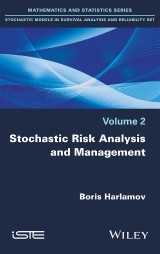Details
Stochastic Risk Analysis and Management
1. Aufl.
|
139,99 € |
|
| Verlag: | Wiley |
| Format: | EPUB |
| Veröffentl.: | 07.02.2017 |
| ISBN/EAN: | 9781119388869 |
| Sprache: | englisch |
| Anzahl Seiten: | 164 |
DRM-geschütztes eBook, Sie benötigen z.B. Adobe Digital Editions und eine Adobe ID zum Lesen.
Beschreibungen
<p>The author investigates the Cramer –Lundberg model, collecting the most interesting theorems and methods, which estimate probability of default for a company of insurance business. These offer different kinds of approximate values for probability of default on the base of normal and diffusion approach and some special asymptotic.</p>
<p><b>Chapter 1. Mathematical Bases 1</b></p> <p>1.1. Introduction to stochastic risk analysis 1</p> <p>1.1.1. About the subject 1</p> <p>1.1.2. About the ruin model 2</p> <p>1.2. Basic methods 4</p> <p>1.2.1. Some concepts of probability theory 4</p> <p>1.2.2. Markov processes 14</p> <p>1.2.3. Poisson process 18</p> <p>1.2.4. Gamma process 21</p> <p>1.2.5. Inverse gamma process 23</p> <p>1.2.6. Renewal process 24</p> <p><b>Chapter 2. Cramér-Lundberg Model 29</b></p> <p>2.1. Infinite horizon 29</p> <p>2.1.1. Initial probability space 29</p> <p>2.1.2. Dynamics of a homogeneous insurance company portfolio 30</p> <p>2.1.3. Ruin time 33</p> <p>2.1.4. Parameters of the gain process 33</p> <p>2.1.5. Safety loading 35</p> <p>2.1.6. Pollaczek-Khinchin formula 36</p> <p>2.1.7. Sub-probability distribution G+ 38</p> <p>2.1.8. Consequences from the Pollaczek-Khinchin formula 41</p> <p>2.1.9. Adjustment coefficient of Lundberg 44</p> <p>2.1.10. Lundberg inequality 45</p> <p>2.1.11. Cramér asymptotics 46</p> <p>2.2. Finite horizon 49</p> <p>2.2.1. Change of measure 49</p> <p>2.2.2. Theorem of Gerber 54</p> <p>2.2.3. Change of measure with parameter gamma 56</p> <p>2.2.4. Exponential distribution of claim size 57</p> <p>2.2.5. Normal approximation 64</p> <p>2.2.6. Diffusion approximation 68</p> <p>2.2.7. The first exit time for the Wiener process 70</p> <p><b>Chapter 3. Models With the Premium Dependent on the Capital 77</b></p> <p>3.1. Definitions and examples 77</p> <p>3.1.1. General properties 78</p> <p>3.1.2. Accumulation process 81</p> <p>3.1.3. Two levels 86</p> <p>3.1.4. Interest rate 90</p> <p>3.1.5. Shift on space 91</p> <p>3.1.6. Discounted process 92</p> <p>3.1.7. Local factor of Lundberg 98</p> <p><b>Chapter 4. Heavy Tails 107</b></p> <p>4.1. Problem of heavy tails 107</p> <p>4.1.1. Tail of distribution 107</p> <p>4.1.2. Subexponential distribution 109</p> <p>4.1.3. Cramér-Lundberg process 117</p> <p>4.1.4. Examples 120</p> <p>4.2. Integro-differential equation 124</p> <p><b>Chapter 5. Some Problems of Control 129</b></p> <p>5.1. Estimation of probability of ruin on a finite interval 129</p> <p>5.2. Probability of the credit contract realization 130</p> <p>5.2.1. Dynamics of the diffusion-type capital 132</p> <p>5.3. Choosing the moment at which insurance begins 135</p> <p>5.3.1. Model of voluntary individual insurance 135</p> <p>5.3.2. Non-decreasing continuous semi-Markov process 139</p> <p>Bibliography 147</p> <p>Index 149</p>
<strong>Boris Harlamov</strong>, Head of Laboratory of Institute of Problems of Mechanical Engineering (IPME), RAN.


















